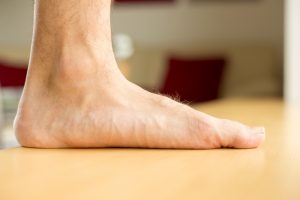
A common condition of the foot structure, flat feet, is caused by a partial or total collapse of the arch of the foot. People may experience “toe drift” which is when the toes and front part of the foot point outward. This can also be caused due to rheumatoid arthritis, diabetes and obesity. This deformity can cause people to have bunions or hammertoes.
Painful progressive flatfoot, otherwise known as tibialis posterior tendonitis or adult-acquired flatfoot, refers to inflammation of the tendon of the tibialis posterior. This condition arises when the tendon becomes inflamed, stretched, or torn. Left untreated, it may lead to severe disability and chronic pain. People are predisposed to tibialis posterior tendonitis if they have flat feet or an abnormal attachment of the tendon to the bones in the midfoot.
Flexible Flatfoot is a common type of flatfoot, it means that you are standing, your foot will be flat and when you are not bearing weight, your arch will return to its normal position. Flexible flatfoot begins in childhood and continues on to adulthood. As you get older, this deformity will cause the tendons and ligaments to stretch or tear and become inflamed.
Symptoms:
- Pain in heel, arch, ankle or the side of your foot
- Weakness in foot or leg
- Stiffness
Treatments:
- Orthotics
- To provide arch support while using shoes
- Medication
- NSAIDS such as Ibuprofen to help decrease pain and inflammation
- Physical Therapy
- Provide relief with stretches
- Surgery
- May be needed depending on severity
Prevention Tips:
- Wear shoes with proper arch support
- Avoid prolonged standing or walking on hard surfaces
- Maintain a healthy weight to reduce pressure on your feet
- Stretch regularly to keep foot and ankle muscles flexible
Please consult your provider before taking any medications. Schedule an appointment with Dr. Rappette or Dr. Pandya to be evaluated for any foot concerns and choose the best treatment plan for you.
This information is provided by the American College of Foot and Ankle Surgeons.
